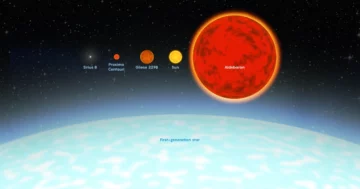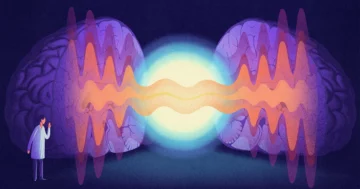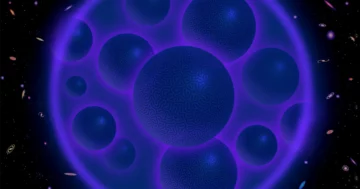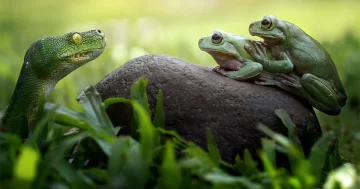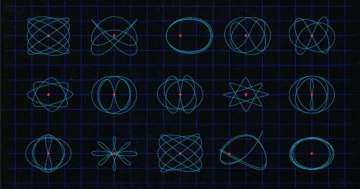
If you’ve ever taken a math test, you’ve probably met a grazing goat. Usually it’s tied to a fence post or the side of some barn, left there by an absent-minded farmer to graze on whatever grass it can reach. When you meet a grazing goat, your job is to calculate the total area of the region it can graze on. It’s a math test, after all.
Math teachers have stymied students by sticking goats in strangely shaped fields for hundreds of years, but one particular grazing goat problem has gotten the goat of mathematicians for more than a century. Until last year they were only able to find approximate answers to the problem, and it took a new approach with some very advanced mathematics to finally produce an exact solution. Let’s take a look at how a question you might find on a math test can turn into a problem that stumps mathematicians for over a century.
The simplest kind of grazing goat problem has the hungry animal attached to the side of a long barn by a fixed length of rope.
Usually in these problems we want to find the area of the region the goat has access to. What does that region look like?
With the leash pulled taut the goat can make a semicircle and can reach anything inside it. The area of a circle is A = πr2, so the area of a semicircle is A = $latex frac{1}{2}$πr2. If, for example, the rope has length 4, then the goat could graze in a region with area A = $latex frac{1}{2}$π × 42 = 8π square units.
This straightforward setup doesn’t pose much of a challenge to the math student or to the goat, so let’s make it more interesting. What if the goat is tied to the side of a square barn?
Let’s say the rope and the side of the barn both have length 4, and that the rope is attached to the middle of one side. What’s the area of the region the goat has access to now?
Well, the goat still has access to the same semicircle as in the first problem.
But the goat can also continue around the corner of the barn. Once it’s at the corner, the goat has two more units of rope to work with, so it can sweep out another quarter circle of radius 2 on either side of the barn.
The goat can access the semicircle of radius 4 plus two quarter circles of radius 2, for a total area of A = $latex frac{1}{2}$π × 42 + $latex frac{1}{4}$π × 22 + $latex frac{1}{4}$π × 22 = 10π square units.
You can make the problem more challenging by changing the shape of the obstruction. I’ve seen goats attached to triangles, hexagons and even concave shapes.
You can also make a new math question from an old one by reversing it: Instead of starting with rope length and finding the area, you can start with the area and find the rope length.
For example, let’s stick with our square barn and ask a new question: How long would the rope have to be for the goat to have access to a total of 50 square units of area? Reversing a math problem can breathe new life into an old idea, but it also makes this problem much more challenging.
First, notice that the shape of the region depends on the length of the rope. For example, if the rope is shorter than 2 units in length, the goat can’t get around the corner of the barn, so the region will only be a semicircle.
If the rope is longer than 2 units, the goat can get around the corner, as we saw above.
And if the rope is longer than 6 units, the goat can get behind the barn, creating another set of quarter circles to consider. (If the rope gets much longer, there will be overlap. See the exercises at the end of the column for an example of this.)
We want to find the rope length that gives us 50 square units of total area. The way to do this mathematically is to set our area formula equal to 50 and solve for r. But each kind of region has a different area formula. Which one do we use?
Figuring this out requires a little casework. If r ≤ 2 the area of the region is A = $latex frac{1}{2}$πr2. The biggest area would occur when r = 2, which yields a total area of A = $latex frac{1}{2}$π × 22 = 2π ≈ 6.28. This is less than 50, so we know we need more than 2 units of rope.
If 2 < r ≤ 6, this gives us the semicircle plus the two quarter circles we encountered before. The radius of the semicircle is r, and the radius of the quarter circles is r – 2, since two units of rope are needed to get to the corner and whatever rope remains acts like the radius of the quarter circle centered at the corner.
The area of this semicircle is $latex frac{1}{2}$πr2, and the area of each quarter circle is $latex frac{1}{4}$π(r – 2)2. Adding this up gives us a total area of
$latex begin{aligned}A&=frac{1}{2} pi r^{2} +frac{1}{4}pi (r-2)^{2} + frac{1}{4}pi (r-2)^{2}\[1pt]
\A &=frac{1}{2} pi r^{2} + frac{1}{2}pi (r-2)^{2}.end{aligned}$
We get the biggest possible area when r = 6, which gives an area of A = $latex frac{1}{2}$π × 62 + $latex frac{1}{2}$π × 42 = 26π ≈ 81.68 square units. Since 50 < 26π, that means the r that will give us 50 square units of area must be less than 6.
Knowing that r must be between 2 and 6 units settles the question of which area formula we should use: When 2 < r ≤ 6, the area is A = $latex frac{1}{2}$πr2 + $latex frac{1}{2}$π(r – 2)2. To find the exact value of r that gives us 50 square units of area, we set up this equation:
50 = $latex frac{1}{2}$πr2 + $latex frac{1}{2}$π(r – 2)2.
Notice that this is another way in which our reversed question is more complicated than the original: Instead of just computing the area the goat can reach, we need to solve an equation to figure out the length of the rope. To do that, we need to isolate r. We have to use arithmetic and algebra to get r by itself on one side of the equation, and that will tell us exactly what r must be.
Our equation may look a little intimidating at first, but it’s just a quadratic equation in r. There’s a standard procedure for solving such equations: We rearrange it in the form ar2 + br + c = 0 and then use the quadratic formula. A little algebra and arithmetic does the trick.
50 = $latex frac{1}{2}$πr2 + $latex frac{1}{2}$π(r – 2)2
$latex frac{100}{pi}$ = r2 + (r – 2)2
$latex frac{100}{pi}$ = 2r2 – 4r + 4
0 = 2r2 – 4r + 4 – $latex frac{100}{pi}$.
This may not be the most beautiful mathematical expression in the world, but it’s just a quadratic equation, so we can apply the quadratic formula to solve exactly for r. This gives us an answer of
r = 1 + $latexsqrt{frac{50}{pi} – 1}$ ≈ 4.86.
Because we were able to isolate r in our equation, we now know exactly how long the rope must be to get an area of 50 square units. (Notice that the value of r we found is between 2 and 6, as expected.)
As challenging as this reversed goat grazing problem was compared to the initial ones we looked at, mathematicians discovered that the problem becomes even more challenging when you stick the goat inside the barn. So challenging, in fact, that they couldn’t solve it exactly.
Let’s put the goat inside our square barn with side length 4 and attach the rope to the middle of a wall. How long does the rope need to be for the goat to have access to half the area inside the barn?
As above, part of the challenge is that the shape of the region depends on the value of r. To get half the area of the square we need r to be longer than half the side of the barn but shorter than the full side, which gives us a region like this.
Finding a formula for the area of this region isn’t so easy. We can imagine the region as one sector of a circle of radius r plus two right triangles, and then use some high school geometry to get a formula. But as we’ll soon see, the mixing of circles and triangles is going to cause some trouble.
Let’s start with the triangles. The Pythagorean theorem tells us that the length of the missing leg in each right triangle is $latexsqrt{r^{2}-4}$. This makes the area of one of the triangles $latex frac{1}{2}$ × 2 × $latexsqrt{r^{2} – 4}$ = $latexsqrt{r^{2} – 4}$, so the two triangles together have an area of 2 $latexsqrt{r^{2}-4}$.
Now for the circular sector.
The area of a sector is A = $latexfrac{1}{2}r^{2}$θ, where θ is the measure of the central angle (in radians, not degrees). We need a formula for the area in terms of r, so we need to express the angle θ in terms of r. To do this, we’ll use the law of cosines, an underappreciated theorem from high school trigonometry.
Applying the law of cosines to the isosceles triangle with sides r, r and 4 gives us
42 = r2 + r2 – 2r2cosθ,
which we can solve for cosθ:
cosθ = $latex frac{2 r^{2}-16}{2 r^{2}}$ = $latex frac{r^{2}-8}{r^{2}}$.
To isolate θ, we need to take the inverse cosine, or arccosine, of both sides of the equation. This gives us
θ = arccos $latex left(frac{r^{2}-8}{r^{2}}right)$.
Now we have the angle θ in terms of r, so we can now express the area of our sector in terms of r and r alone.
A = $latex frac{1}{2}$r2θ
A = $latex frac{1}{2}$r2arccos $latex left(frac{r^{2}-8}{r^{2}}right)$.
Our final area formula is the sum of the sector area and the area of the two triangles, which is
A = $latex frac{1}{2}$r2arccos $latex left(frac{r^{2}-8}{r^{2}}right)$ + 2 $latexsqrt{r^{2}-4}$.
We now have a formula for the area of the region accessible to the goat inside the square entirely in terms of r. Now we just need to find the value of r that gives the goat access to half the square. The entire square has area 16, so all we have to do is plug A = 8 into our equation and solve for r and we’ll be finished.
8 = $latex frac{1}{2}$r2arccos $latex left(frac{r^{2}-8}{r^{2}}right)$ + 2 $latexsqrt{r^{2}-4}$.
There’s just one small problem: It’s not possible to solve for r in this equation.
That is, it’s not possible to solve exactly for r in this equation. We can use a calculator to approximate the value of r that makes this equation true (r ≈ 2.331), but we can’t isolate r in our equation. The mixing of trigonometric functions and polynomial functions in our equation creates obstacles we can’t get around.
We could try to get the r’s out from inside the arccosine function, but to do that we’d have to put the other r’s inside a cosine function. Either way we’d be dealing with an equation that involves a transcendental function, like an exponential or trigonometric function. Transcendental functions can’t be simply expressed in terms of the usual algebraic operations like addition and multiplication, and so in general transcendental equations can’t be solved exactly.
This issue lies at the heart of a famous grazing goat problem posed in the 19th century where the goat was placed inside a circular barn. As in our square barn problem, the goal was to determine how long the rope had to be for the goat to have access to half the region.
The region accessible by the goat takes the shape of a “lens” — two circular segments stacked together.
It’s possible to use high school geometry to find the area of this lens in terms of the rope length r, but the formula is much more complicated than it is for the square. And when you set this equal to half the area of the circular barn, you run into the same problem we ran into inside the square: You just can’t isolate r. You can approximate it, but you can’t solve for r exactly.
This sort of obstinacy is no more appealing in an equation than it is in a goat. For over 100 years, mathematicians tried to find an exact solution to this goat-in-a-circle puzzle, but it wasn’t until last year that a German mathematician finally figured it out. He used complex analysis — mathematics far removed from the geometry of circles and squares most goat problems rely on — to solve explicitly for r. And while using something as advanced as a contour integral to find the length of a goat’s leash may seem like overkill, there’s always mathematical satisfaction in doing what couldn’t be done before. And there’s always the possibility that these new methods, even if they arise from studying a silly problem about goats, might lead to insights beyond the barnyard.
Exercises
1. If the goat is attached to the middle of the side of a square barn with side length 4 by a rope of length 8, outside the barn, what’s the area of the region the goat has access to?
2. If the goat is attached to the corner of a square barn with side length 4 by a rope of length 8, outside the barn, what’s the area of the region the goat has access to?
3. Suppose the goat is inside an equilateral triangle of side 4 attached to a vertex. How long would the rope have to be for the goat to have access to half the triangle?
4. If the goat is attached to the middle of the side of a square barn with side length 4 by a rope of length 10, outside the barn, what’s the area of the region the goat has access to?
Answers
Click for Answer 1:
The region is comprised of a semicircle of radius 8, two quarter circles of radius 6, and two quarter circles of radius 2. Since 8 is equal to half the perimeter of the barn, the two semicircles behind the barn meet up at the midpoint.
The area of this region is $latexfrac{1}{2}$π × 82 + $latexfrac{1}{2}$π × 62 + $latexfrac{1}{2}$π × 22 = 52π.
Click for Answer 2:
This region is comprised of three-quarters of a circle of radius 8 and two quarter circles of radius 4.
This area is $latexfrac{3}{4}$π × 82 + $latexfrac{1}{2}$π × 42 = 56π. As a challenge, think about what happens if the rope has length 10.
Click for Answer 3:
Since the angles of an equilateral triangle are 60 degrees, the region the goat has access to is one-sixth of a circle of radius r, which has area $latexfrac{1}{6}$πr2.
The area of an equilateral triangle is $latexfrac{sqrt{3}}{4}$s2, so the area of the triangle of side length 4 is $latexfrac{sqrt{3}}{4}$ × 42 = 4 $latex{sqrt{3}}$. We set the two areas equal, $latexfrac{1}{6}$πr2 = $latexfrac{1}{2}$ × 4 $latex{sqrt{3}}$, and solve for r to get r = $latexsqrt{frac{12 sqrt{3}}{pi}}$. Notice how we can solve exactly for r here, unlike when the region mixed circular sectors and triangles.
Click for Answer 4:
$latexfrac{1}{6}$π × 42 – $latexfrac{sqrt{3}}{4}$ × 42 = $latexfrac{16}{3}$π – 4 $latex{sqrt{3}}$. So the total area is 90π – $latexleft(frac{16}{3} pi-4 sqrt{3}right)$ = $latexfrac{254}{3}$π + 4 $latex{sqrt{3}}$. (Note: This overlap would be much more difficult to find if the two circles had different radii, which is why finding the area of the lens mentioned above is so difficult.)
Source: https://www.quantamagazine.org/solve-math-equations-that-are-stubborn-as-a-goat-20210506/
- 100
- access
- All
- analysis
- AREA
- around
- Biggest
- Cause
- challenge
- Circle
- Column
- computing
- continue
- Creating
- dealing
- discovered
- Fields
- Figure
- Finally
- First
- form
- full
- function
- General
- geometry
- here
- High
- How
- How To
- HTTPS
- Hundreds
- Hungry
- idea
- insights
- integral
- IT
- Job
- Law
- lead
- Long
- looked
- math
- mathematics
- measure
- mixed
- Operations
- Other
- puzzle
- Run
- School
- Sectors
- set
- settles
- small
- So
- SOLVE
- square
- start
- Student
- Sweep
- teachers
- tells
- test
- us
- value
- Work
- world
- year
- years

